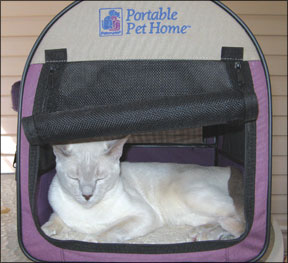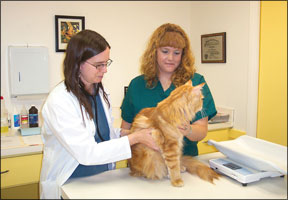Rubber gloves, stethoscopes, needles, white coats …… the mere thought of going to the doctor or dentist can send shivers up the spine of many patients. Our feline friends are no different. Luckily, cats dont consult a calendar in the days or weeks before a trip to the veterinarian, so they are spared a lot of needless time worrying beforehand. But make no mistake about it: Your cat will know somethings up the minute she sees the cat carrier in your hand.

Bev Caldwell
288
Even a well adjusted, outgoing feline may become anxious and shy at a veterinary clinic; the sounds of barking dogs and meowing cats is enough to make her heart start beating a little faster. If your cat is reluctant to move or her pupils are dilated, she is experiencing some mild stress. A moderately stressed cats hair may be standing on end or she may hiss, growl or spit. A cat who is breathing through her mouth or even panting is extremely agitated. If your normally calm cat has exhibited any of these behaviors, read on to learn how you make a visit to the veterinarian less stressful.
Start Out Early
You can begin to ease your cats anxiety level before she ever sets a paw inside the veterinarians office. If possible, begin training her when she is a kitten. Purchase a secure, well-ventilated carrier and place your felines favorite blanket and toy inside. A top-loading carrier is preferable as it allows you to gently lower your cat inside (if you have a front-loading carrier, try and back your cat in, rather than pushing her in headfirst). Leave the carrier out in the open and allow your cat to climb in and out at will.
“If a cat is comfortable, feeding her in the carrier may be another way to get her accustomed to being in the carrier,” says Paul Maza, DVM, a consultant with Cornell University’s Feline Health Center. “Using synthetic facial pheromones (such as Feliway) can also help. And dont be surprised if your cat starts sleeping in the carrier!”
You may wish to start taking your cat for an occasional ride in the car. Its true that the words “car” and “cat” dont usually go well together, but it is possible to get your cat used to riding in a car. Start out with short trips, or even by leaving the car idling in the driveway for a few minutes with your cat inside. Avoid feeding your cat for a few hours before you travel, which will reduce the incidence of nausea or vomiting.
Arrange to stop by your veterinarians office for a meet-and-greet outside of your cat’s regular appointments to allow her to get acquainted with the veterinarian and staff and explore her new surroundings. This will help make subsequent visits less ominous. Ideally, the veterinary office will have separate entrances and waiting area for cats and dogs.
Choosing a Veterinarian
Selecting the right veterinarian is one of the most important things

Bev Caldwell
288
you can do to help ensure your cats long-term health and happiness. Begin by interviewing a few veterinarians and choosing one that both you and your cat are comfortable with. If the hospital has multiple veterinarians on staff and your cat seems to like one more than another, schedule appointments with only that doctor.
Once your cat feels (relatively) at ease riding in the car and she has had the opportunity to meet her future doctor, its time to take her for the actual appointment. Plan on arriving a few minutes early so you have ample time to find parking and fill out the necessary paperwork. Be sure your that cat is wearing a collar (with current identification) in the event she becomes frightened and attempts to flee.
And what about sedatives? If your normally docile cat turns into a tiger at the veterinary clinic, you may be tempted to give her a sedative, but in most cases cats should not be sedated prior to an examination or medical procedure. “Sedatives or tranquilizers,” says Dr. Maza, “may alter results of the physical examination, such as heart and respiratory rates.”
A good veterinarian will speak softly to your cat and perhaps stroke her fur before moving on to anything that may be uncomfortable or scary. As your cat relaxes, the veterinarian will begin the examination, administer any necessary vaccinations, and proceed with any other needed procedures (such as trimming the nails or cleaning the ears). At the conclusion of the appointment, lavish praise on your cat for her good behavior. (A hearty thank you to the veterinarian is always a good idea too!)
House Calls for Cats
Many cats are more comfortable remaining at home during a veterinary exam. For this reason, housecall veterinarians are becoming increasingly popular in many areas of the country.
“Most cats are much better behaved at home and the results of the physical examination are more realistic, less attributable to stress,” says Dr. Maza. Many housecall veterinarians have specially equipped vehicles and can offer an extensive range of services. The cost for a housecall visit is usually comparable to an office visit, although additional fees may apply for added travel time and distance.
“If you have multiple cats in your household,” notes Dr. Maza, “usually only one housecall fee is charged for the entire visit.”
A veterinary examination doesnt have to be a nail-biting experience for you or your cat. With a little time and training, even the most fearful feline will accept a doctor visit with little fuss. Now if it were only that easy for humans!



